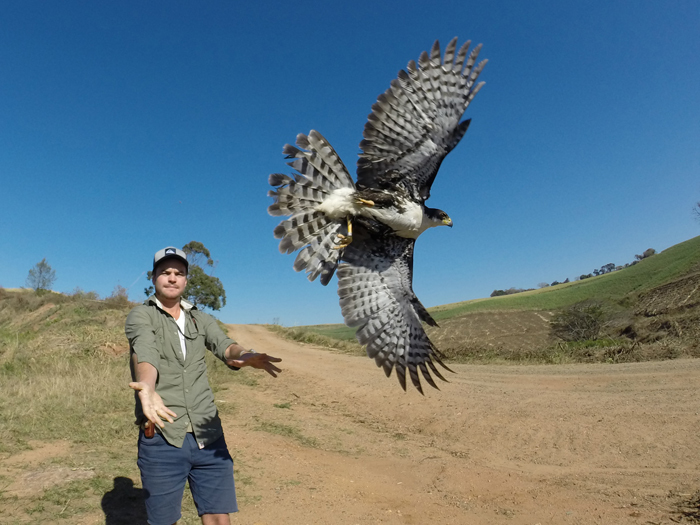Birds of a feather: different colours, same territory
20 May 2016 | Story Helen Swingler. Photo Gareth Tate.
A new paper co-authored by a Department of Biological Sciences trio has shed new light on an old conundrum: why some species occur in different colours and how this variation may provide a selective advantage in novel environments.
Researchers Dr Arjun Amar and Dr Jacqueline Bishop and lead author Gareth Tate, their PhD student, recently published a study on Black Sparrowhawks in the prestigious journal Ecology Letters.
Contrary to their name, Black Sparrowhawks (Accipiter melanoleucus) occur with black or white chest plumage. This phenomenon is known as polymorphism and in some animals the same species can occur in two or more colour types (or morphs) within the same area. While generally rare, these colour polymorphisms have long fascinated evolutionary biologists, including Darwin.
The researchers found that the hunting success of the Black Sparrowhawks in and around Cape Town varied according to the ambient light levels found during their breeding season. Dark birds were more successful hunters in poorer light conditions and light birds did better when it was brighter. Using at-nest cameras, the researchers were able to determine this by measuring how much food adults brought to their chicks during the winter breeding season between April and October.
“We think that dark morph birds capture more prey in duller conditions because they are better camouflaged against darker, cloudier skies. Within our study area, high rainfall coincides with when the species is breeding, and this may also explain why we have so many of this usually rare colour type here,” explained Amar.
“Across the whole of South Africa, we also found that the frequency of the two colour types varies according to the ambient light levels found during the breeding season,” Bishop explained. “Given the broad distribution of the species, we hypothesise that natural selection favours the maintenance of this polymorphism, rather than selecting just one of them.”
Light sensitive
Tate said that the finding would help evolutionary biologists understand how multiple colour varieties can co-exist together in the face of natural selection.
“This is the first study to provide support for the idea that colour polymorphism within some species may be due to different morphs being better adapted to different light conditions.”
It also explains why rare black morphs of the Black Sparrowhawk are on the rise in the Cape Peninsula where the bird is a recent coloniser. Light morphs are generally more widespread across their broad range in Africa where their breeding season occurs in dry, sunny winters, rather than the very wet ones they are faced with in the Western Cape.
“This suggests that the species has responded to strong local selection (a winter breeding season), and given that these birds have only been in the region for the last few decades, this has occurred very quickly,” said Tate. “It's a very exciting finding.”
Largely understudied in South Africa until recently, the Black Sparrowhawk is the biggest African member of the genus Accipiter. It lives mainly in the forests and non-desert areas south of the Sahara Desert. In the Cape Peninsula, the birds also inhabit suburban areas, nesting in large trees and plantations. They prey on other birds such as pigeons and doves.
- Read the full paper in Ecology Letters
- Read about raptor research at the Percy Fitzpatrick Institute
Read a related story:
 This work is licensed under a Creative Commons Attribution-NoDerivatives 4.0 International License.
This work is licensed under a Creative Commons Attribution-NoDerivatives 4.0 International License.
Please view the republishing articles page for more information.










